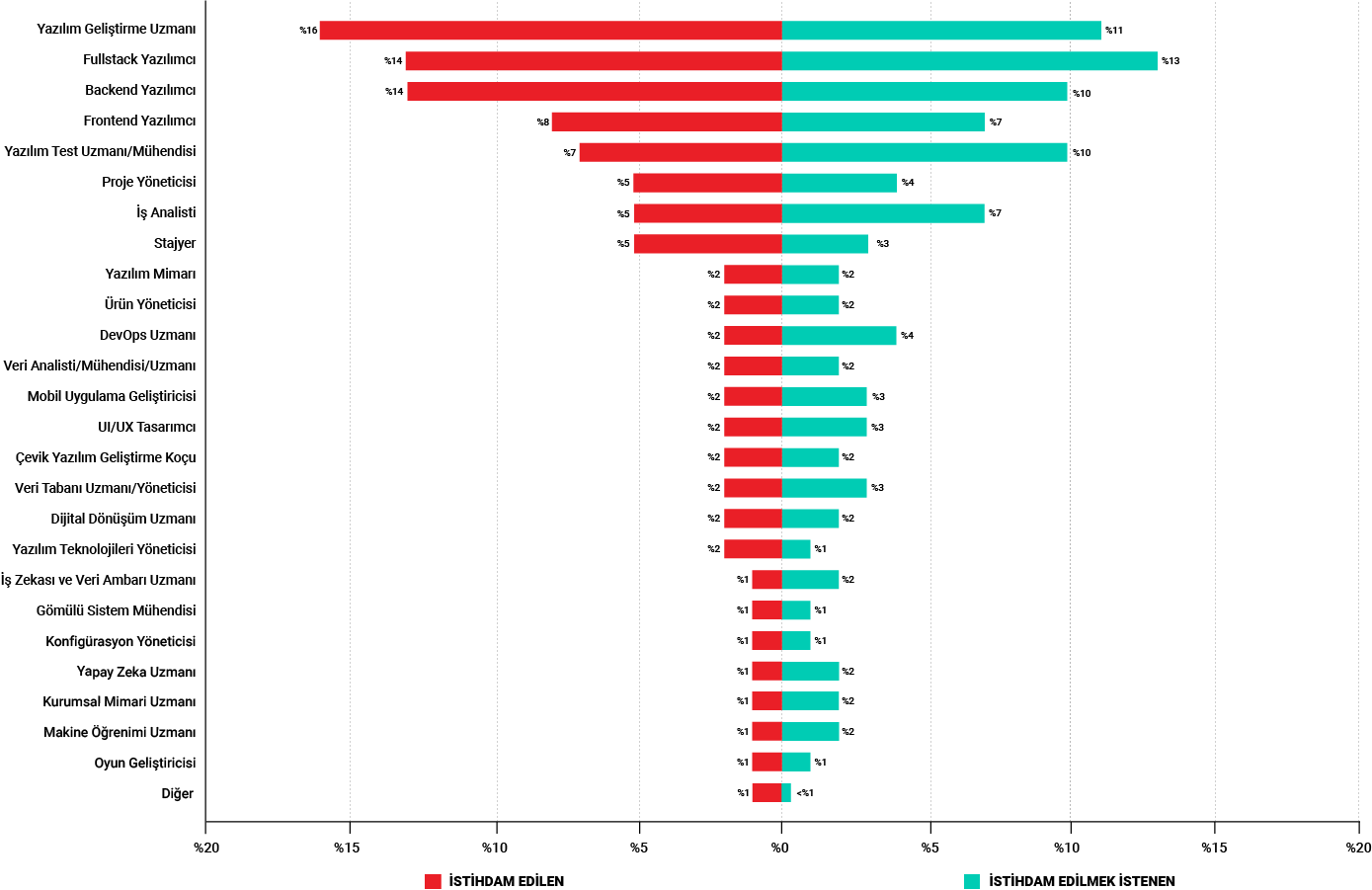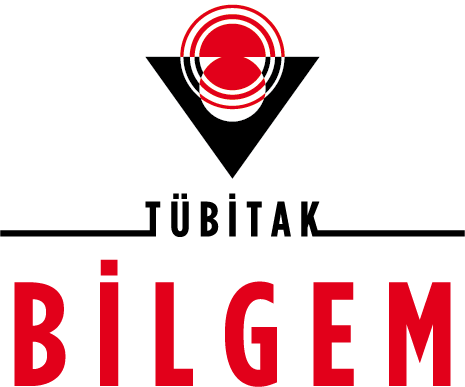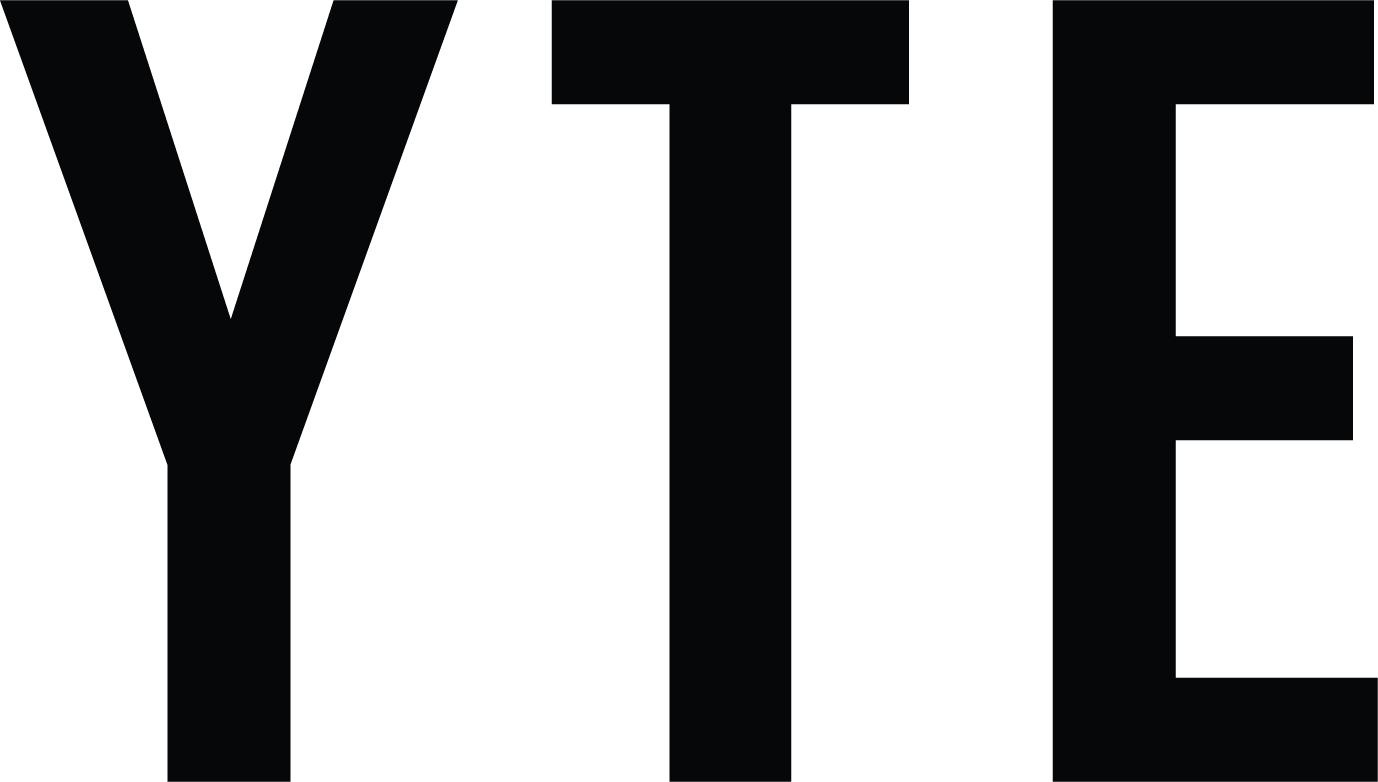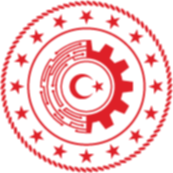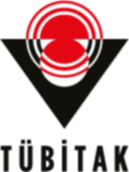YTE
Türkiye Software Technologies Usage Report
- About YTE
- Introduction
- Working Group
- Programming Languages and Software
- Frameworks and Libraries
- Database Technologies
- Development Tools
- Development Environments
- Operating Systems
- Version Control Systems
-
Continuous Integration and
Continuous Delivery Tools - Cloud and Virtualization Usage
- Logging and Monitoring Tools
- Project Management Methodologies
- Project Management Tools
- Communication Tools
- Current and Needed Roles In the Software Industry
- About YTE
- Introduction
- Working Group
-
Programming Languages and
Software Frameworks - Frameworks and Libraries
- Database Technologies
- Development Tools
- Development Environments
- Operating Systems
- Version Control Systems
-
Continuous Integration and
Continuous Delivery Tools - Cloud and Virtualization Usage
- Logging and Monitoring Tools
- Project Management Methodologies
- Project Management Tools
- Communication Tools
-
Current and Needed Roles
In the Software Industry
Software Technologies Research Institute
Software Technologies Research Institute (YTE) carries out R&D activities in the field of software technologies that our country needs and provides software development, digital transformation, software quality monitoring and consultancy services. It is especially involved in strategic, sensitive and critical projects of our country. It uses its R&D studies in software technologies in the projects it develops and shares its experienced knowledge with the sector.
YTE continues to work with the vision of contributing to the development of the informatics ecosystem in order to lead research that makes our country a reference point in the field of software and to implement effective digital transformation strategies.
It is the only public institution in Türkiye to have received CMMI 5 certification.

One of the most critical core competencies essential for realizing our national technology initiative is software development capability. Being proficient in software technologies is essential for pioneering in a rapidly digitizing world shaped by software and artificial intelligence, as well as for delivering better services and maintaining competitiveness.
As TÜBİTAK BİLGEM Software Technologies Research Institute, we conduct research in many areas, ranging from the planning to the proper implementation of digital transformation, and provide support to our institutions in their critical and sensitive projects.
The Türkiye Software Technology Usage Report, which we prepared with the support of the Ministry of Industry and Technology of the Republic of Türkiye, General Directorate of National Technology, aims to guide our institutions aiming for transformation in terms of the technologies they can use and their training plans, and to identify the areas that require investment and development. We prepared our report, which was supported by a significant participation from the private sector and public institutions, with the answers to the questions covering the areas in the software life cycle.
-
CURRENTLY USED:
Technologies currently in use
-
INTENDED TO BE USED:
Technologies desired to be used in the future
-
SATISFIED:
Individuals who currently use a technology and would like to continue using it in the future
-
WILLING:
Individuals who have not previously used a technology but would like to experience it in the future
Working Group
- Manager
- Employee
GENDER
24
FEMALE
216
MALE
EDUCATION
9
HIGH SCHOOL
14
ASSOC. DEGREE
134
BACH. DEGREE
60
MASTER
23
DOCTORATE
EXPERIENCE
3
< 2 YEARS
24
2-9 YEARS
41
10-14 YEARS
39
15-19 YEARS
50
20-24 YEARS
83
≥25 YEARS
AGE
-
< 20 YEARS
1
20-24 YEARS
15
25-29 YEARS
72
30-39 YEARS
101
40-49 YEARS
51
≥50 YEARS
GENDER
200
FEMALE
525
MALE
EDUCATION
28
HIGH SCHOOL
52
ASSOC. DEGREE
493
BACH. DEGREE
138
MASTER
14
DOCTORATE
EXPERIENCE
156
< 2 YEARS
256
2-9 YEARS
123
10-14 YEARS
101
15-19 YEARS
44
20-24 YEARS
45
≥25 YEARS
AGE
5
< 20 YEARS
76
20-24 YEARS
172
25-29 YEARS
305
30-39 YEARS
137
40-49 YEARS
30
≥50 YEARS
Programming Languages and Software Frameworks
-
CURRENTLY USED
-
INTENDED TO BE USED
With the advancement of technology and increasing demand for software solutions, the development in programming languages continues. The growing needs have led to efforts to enhance developer experience and increase diversity in programming languages. Newly emerging languages or new versions of existing languages generally focus on meeting modern needs faster and more reliably.
When we examine the programming languages used in our country, we see parallels with those used worldwide [1]. When evaluating the trend in programming languages and the usage trend in software frameworks, we can say that there is a tendency towards open-source technologies in our institutions.
We observe that SQL is the most commonly used language by developers. For developing enterprise applications, Java and C# are more widely used. When comparing worldwide usage, we can say that JavaScript usage is slightly more common in our country [1].
In comparison to international usage rates, we see that Python is less preferred in our country.
It can be anticipated that time is needed for new languages such as Kotlin, Go, Dart, Rust to become more widespread in our country.
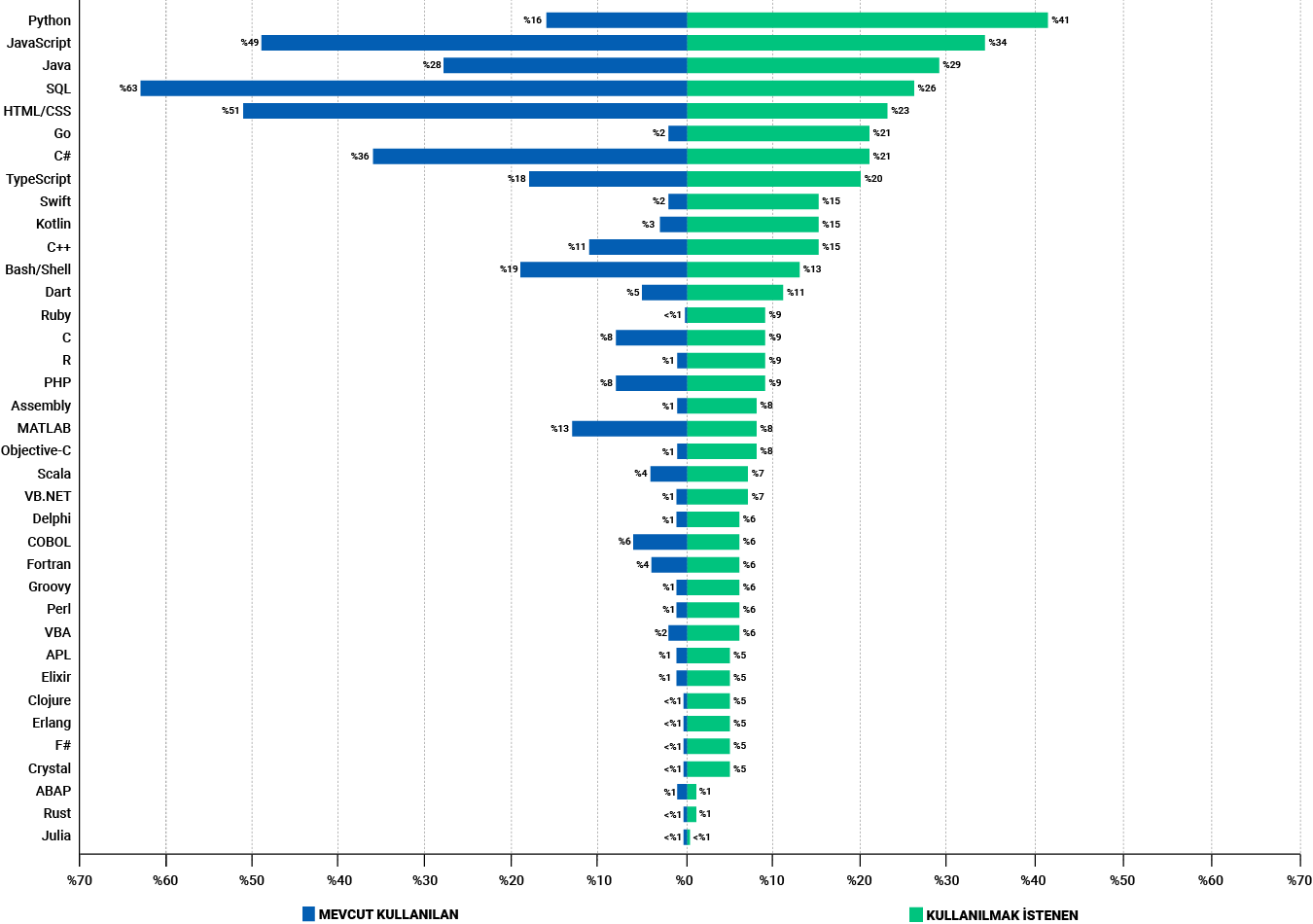
With the advancement of technology and increasing demand for software solutions, the development in programming languages continues. The growing needs have led to efforts to enhance developer experience and increase diversity in programming languages. Newly emerging languages or new versions of existing languages generally focus on meeting modern needs faster and more reliably.
When we examine the programming languages used in our country, we see parallels with those used worldwide [1]. When evaluating the trend in programming languages and the usage trend in software frameworks, we can say that there is a tendency towards open-source technologies in our institutions.
We observe that SQL is the most commonly used language by developers. For developing enterprise applications, Java and C# are more widely used. When comparing worldwide usage, we can say that JavaScript usage is slightly more common in our country [1].
In comparison to international usage rates, we see that Python is less preferred in our country.
It can be anticipated that time is needed for new languages such as Kotlin, Go, Dart, Rust to become more widespread in our country.
Frameworks and Libraries
Web Frameworks
-
CURRENTLY USED
-
INTENDED TO BE USED
We see that the use of Node.js for backend development is widespread, and it is the most desired framework for the future. Since the majority of those who want to use Node.js have not used it before, we can say that it will be preferred more in the future.
Frontend Frameworks Usage Status
-
CURRENTLY USED
-
INTENDED TO BE USED
Frontend Frameworks Satisfaction Status
-
SATISFIED
-
WILLING
Web Frameworks
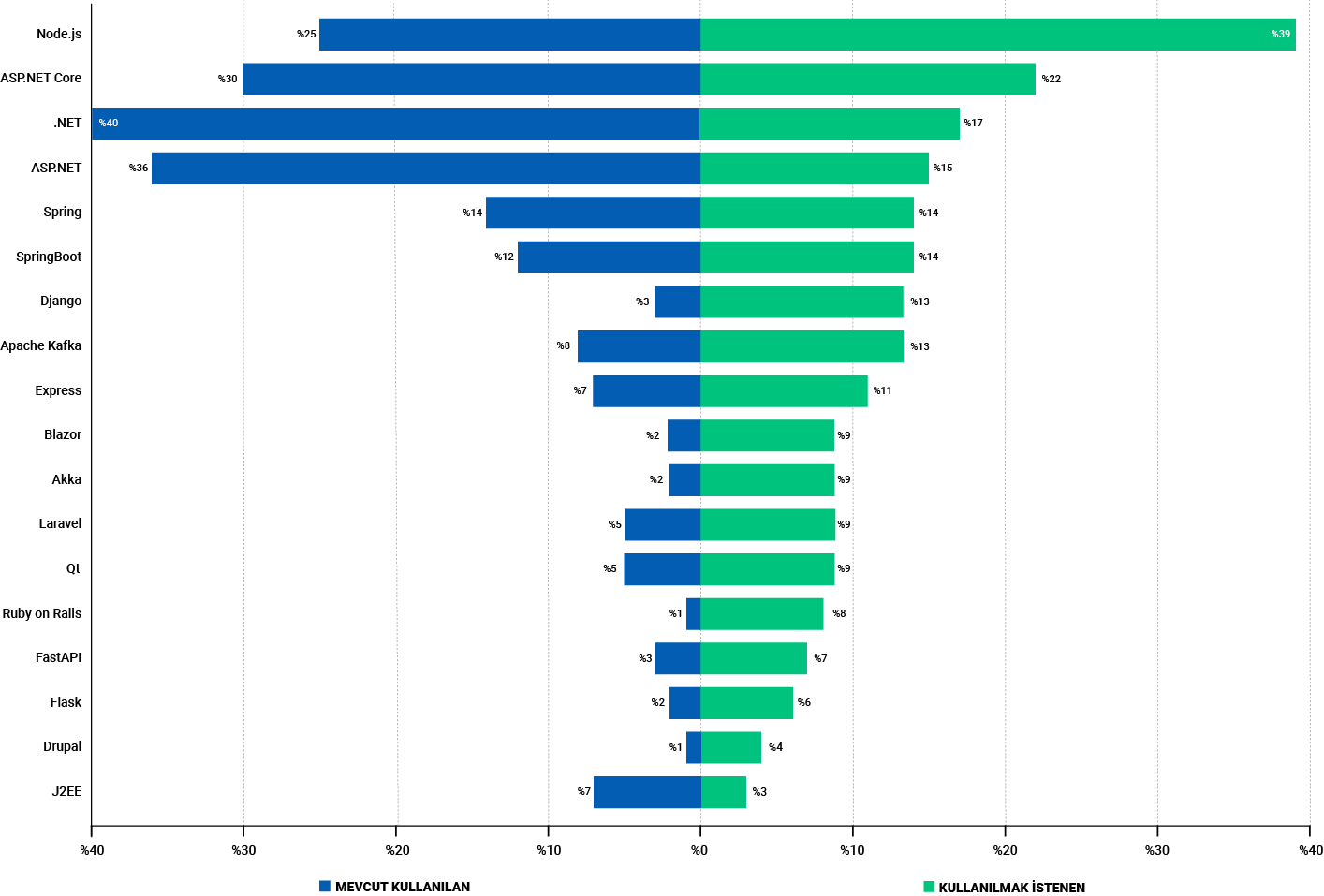
We see that the use of Node.js for backend development is widespread, and it is the most desired framework for the future. Since the majority of those who want to use Node.js have not used it before, we can say that it will be preferred more in the future.
Frontend Frameworks Usage Status
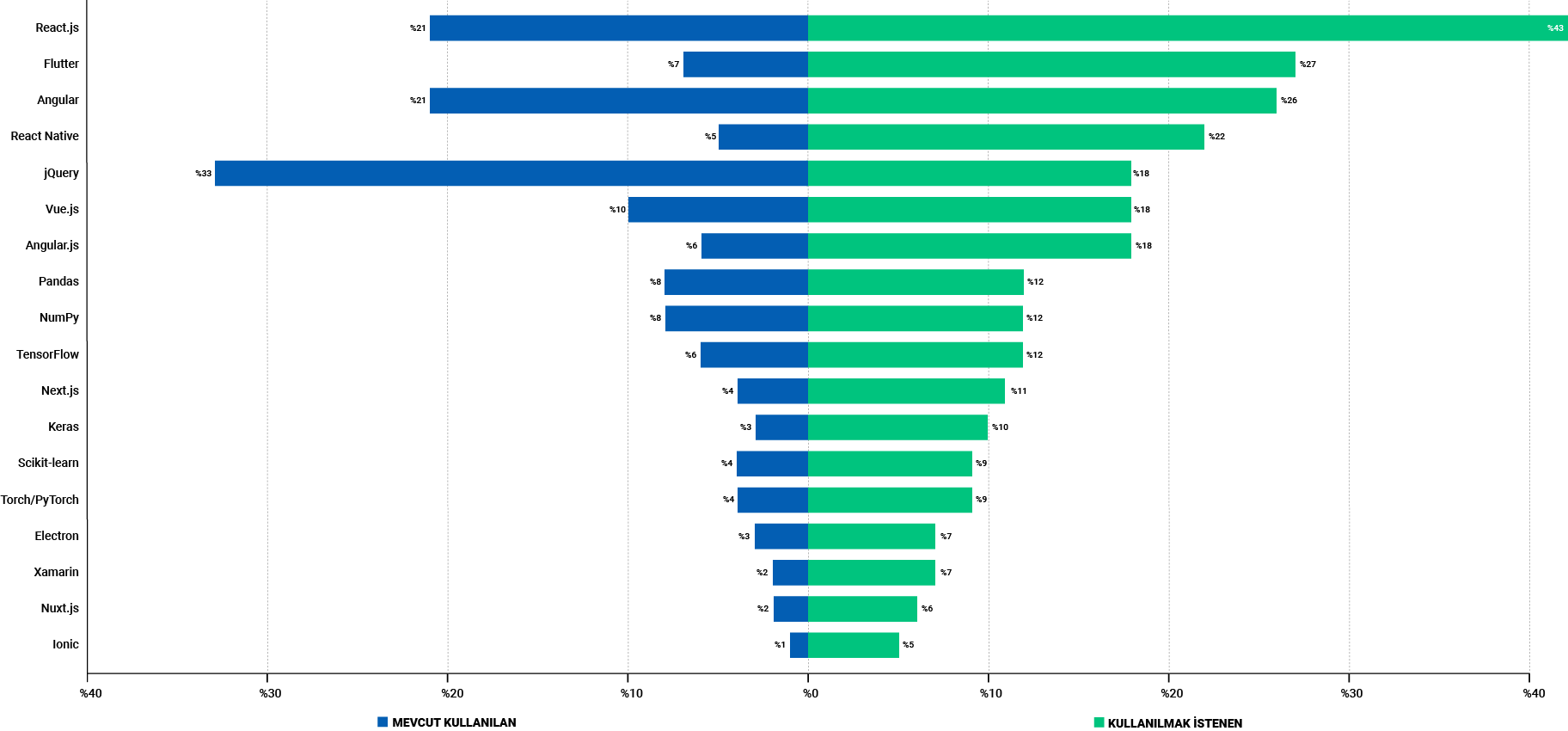
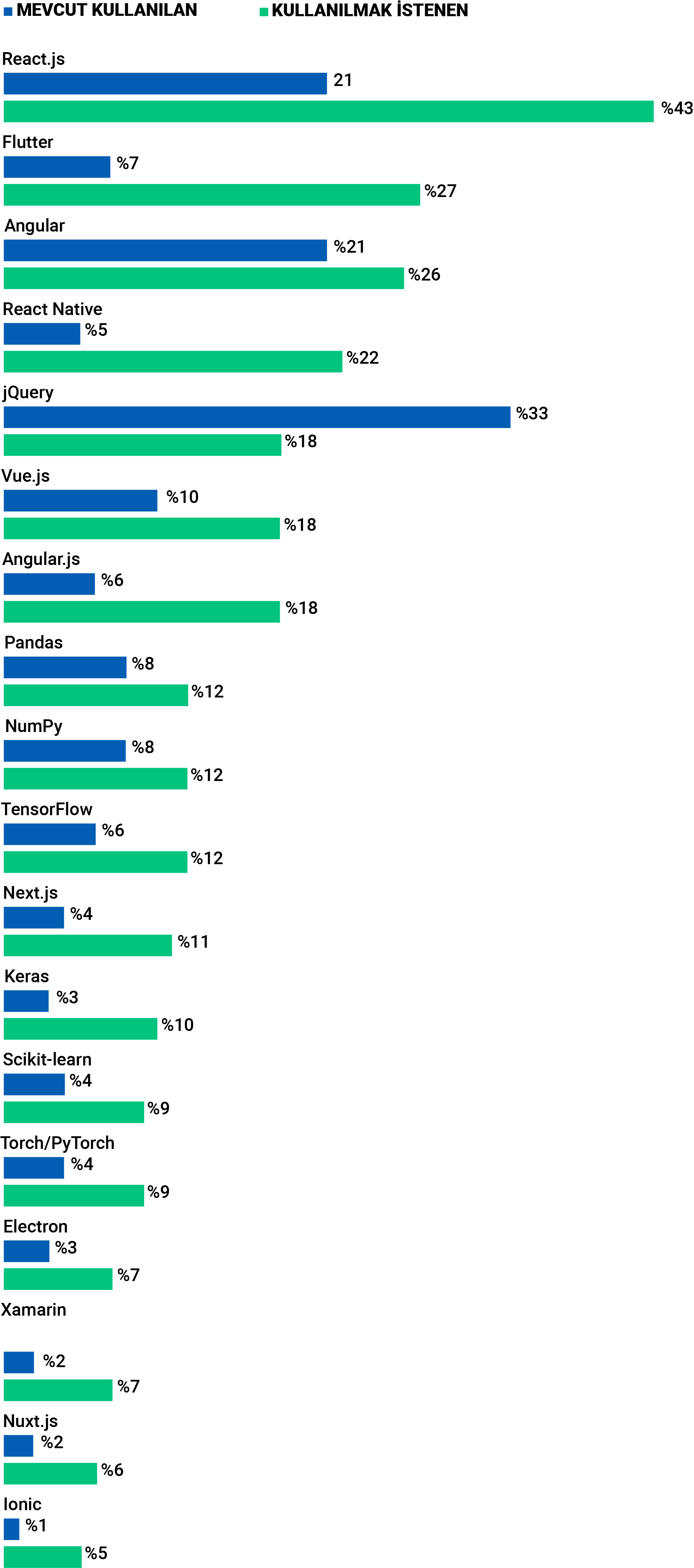
In frontend development, while Angular and React.js are equally used at present, it can be said that the transition to React.js will increase in the future. It is possible to say that the usage trend in both frontend and data science in our country continues parallel to the usage worldwide [1].
Frontend Frameworks Satisfaction Status
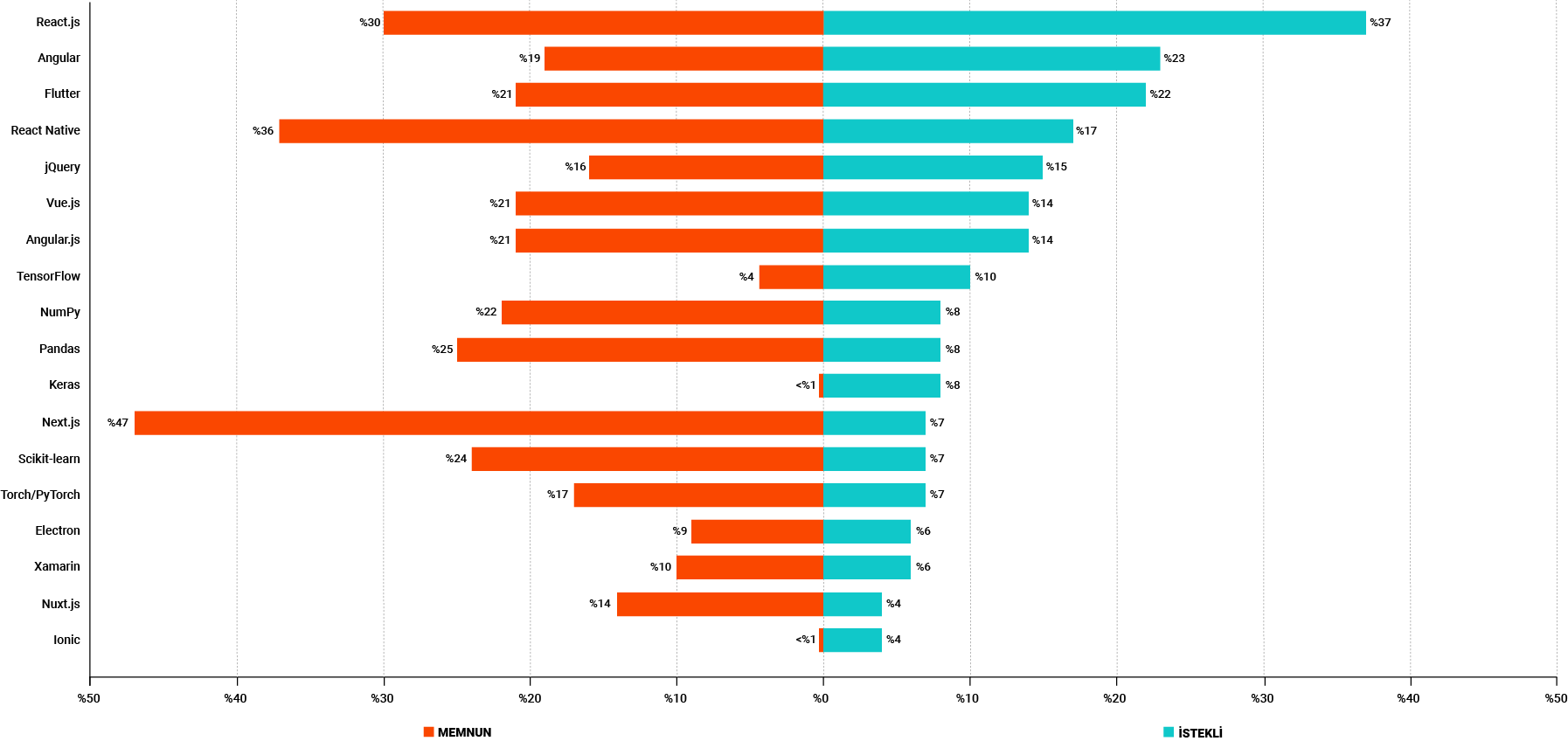
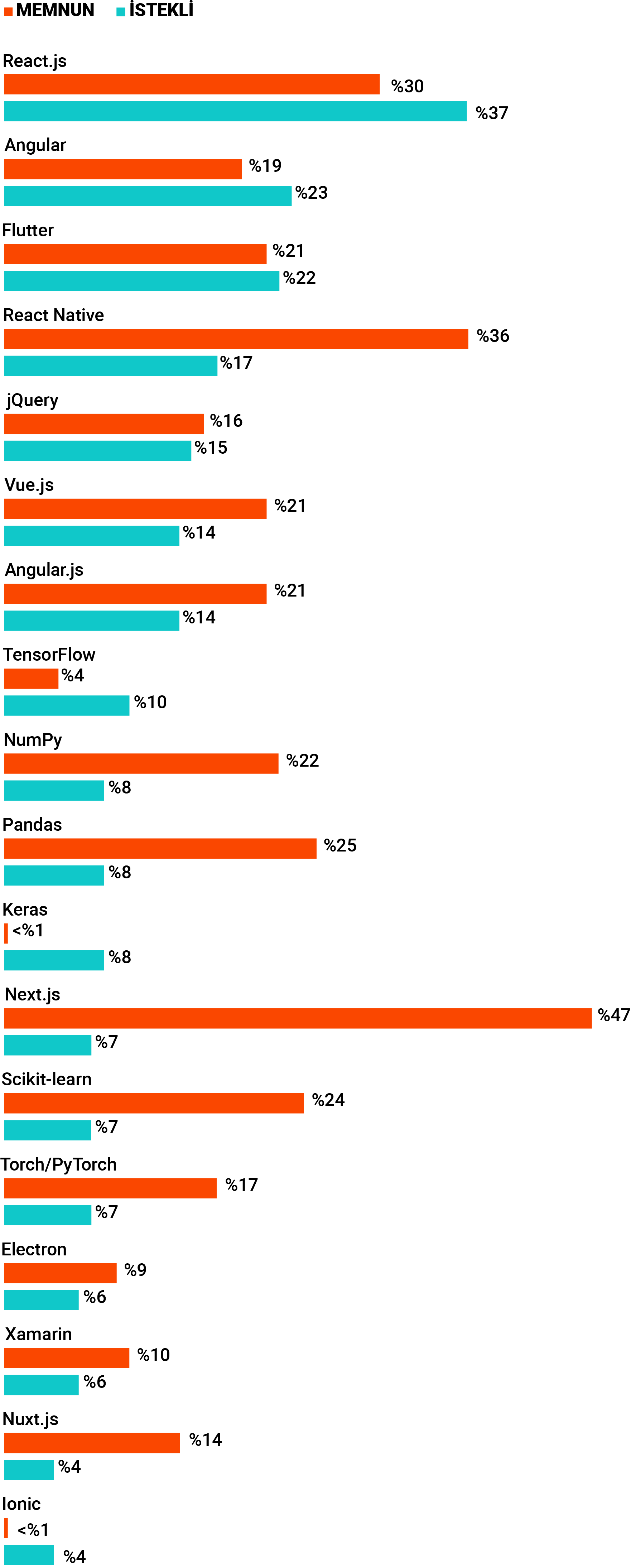
Database Technologies
-
CURRENTLY USED
-
INTENDED TO BE USED
In the realm of database technologies, Microsoft SQL Server stands out as the most preferred database. However, it is encouraging to see that our institutions are leaning more towards open-source solutions, with PostgreSQL being the most desired database for the future. We can say that MariaDB has not gained as much attention in our country as it has globally [1]. Among NoSQL database technologies, MongoDB and Cassandra are currently the most preferred databases. Participants have expressed their intention to continue using MongoDB in the future and to utilize solutions such as Elasticsearch and Redis more extensively.
Relationship Between Programming Languages and Database Technologies
-
C#
-
JAVA
-
PYHTON
-
GO
When examining the relationship between the programming languages used by our institutions and the database technologies:
• Java users predominantly prefer Oracle as their database, followed by open-source databases like PostgreSQL and MySQL.
• Among those who develop software using C#, 73 out of every hundred also use Microsoft SQL Server.
• Python users show a higher preference for open-source databases such as PostgreSQL, MySQL, and MongoDB.
• Go developers predominantly work with NoSQL databases like Elasticsearch and MongoDB, while their relational database preferences are MySQL and PostgreSQL.
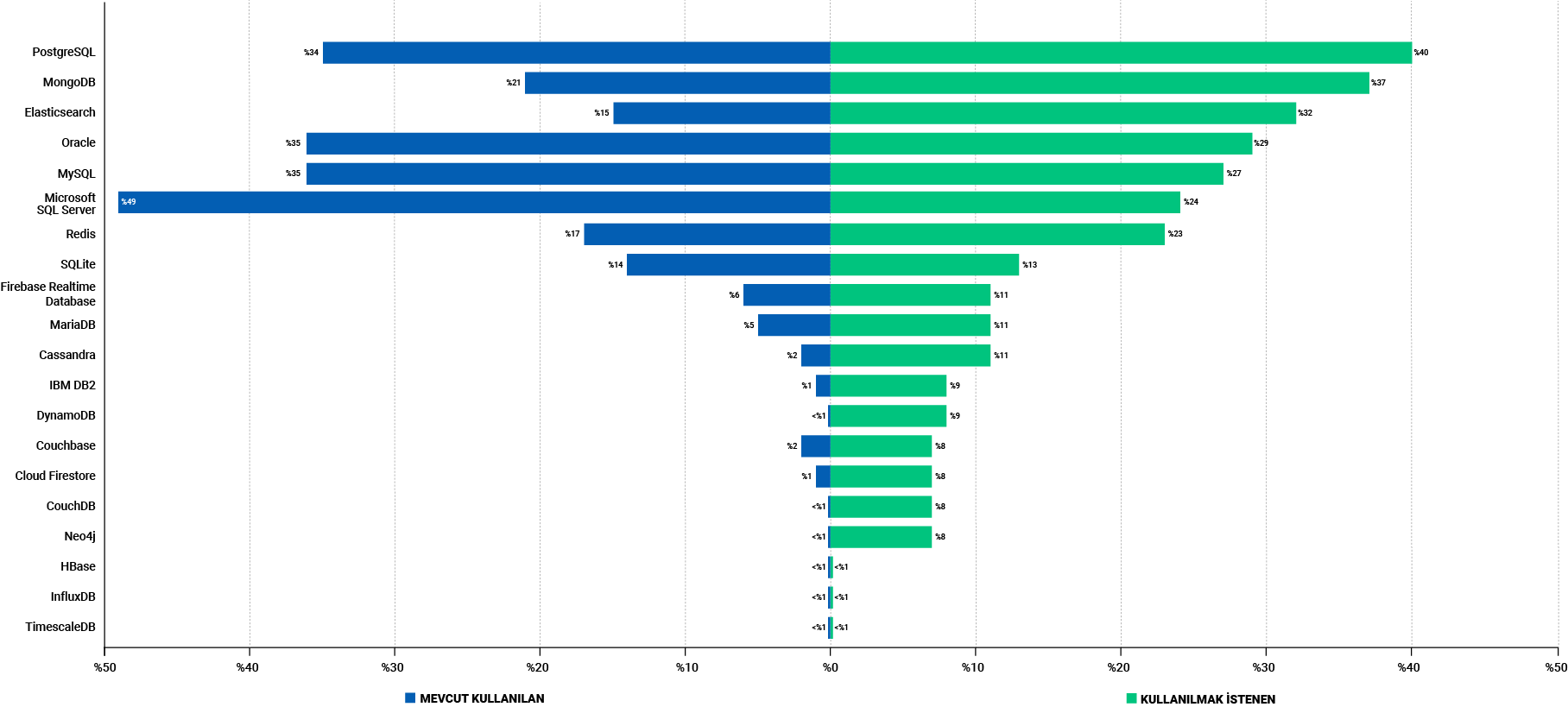
In the realm of database technologies, Microsoft SQL Server stands out as the most preferred database. However, it is encouraging to see that our institutions are leaning more towards open-source solutions, with PostgreSQL being the most desired database for the future. We can say that MariaDB has not gained as much attention in our country as it has globally [1]. Among NoSQL database technologies, MongoDB and Cassandra are currently the most preferred databases. Participants have expressed their intention to continue using MongoDB in the future and to utilize solutions such as Elasticsearch and Redis more extensively.
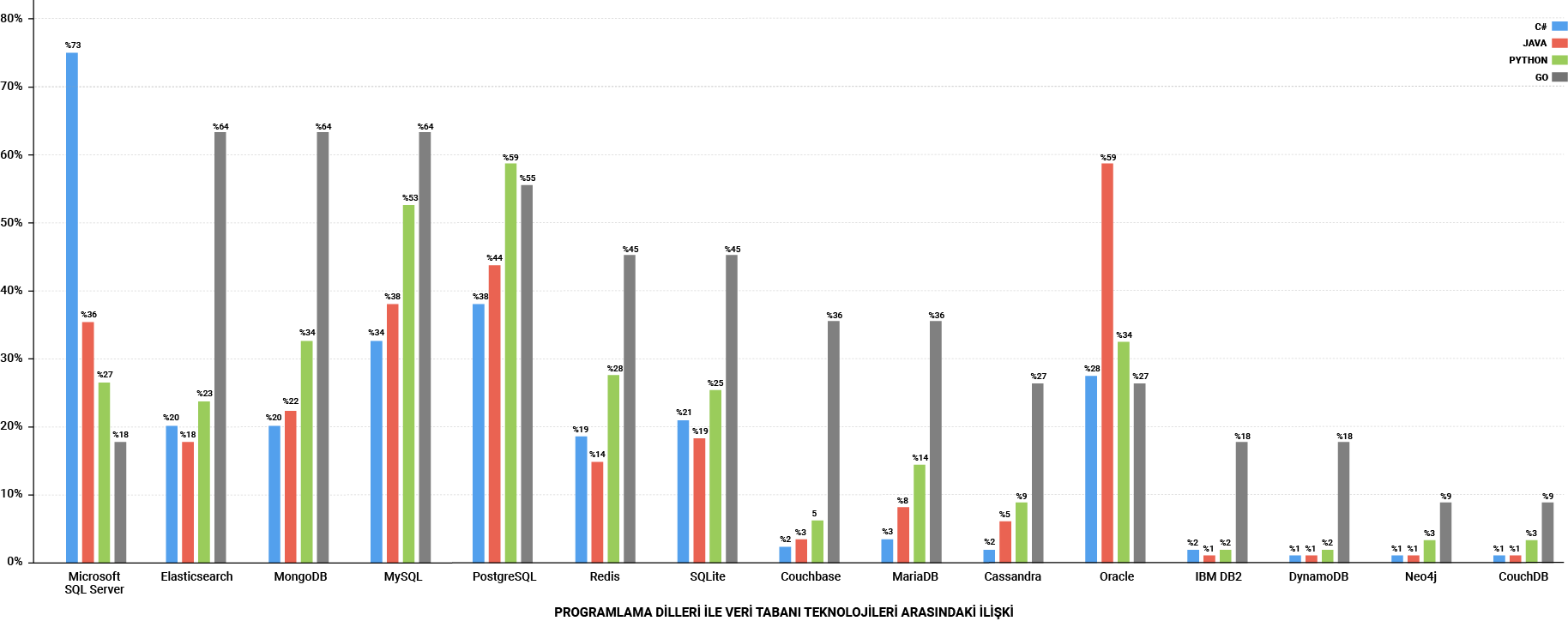
When examining the relationship between the programming languages used by our institutions and the database technologies:
• Java users predominantly prefer Oracle as their database, followed by open-source databases like PostgreSQL and MySQL.
• Among those who develop software using C#, 73 out of every hundred also use Microsoft SQL Server.
• Python users show a higher preference for open-source databases such as PostgreSQL, MySQL, and MongoDB.
• Go developers predominantly work with NoSQL databases like Elasticsearch and MongoDB, while their relational database preferences are MySQL and PostgreSQL.
Development Tools
-
CURRENTLY USED
-
WILLING
-
SATISFIED
Among the development tools, we see that npm stands out as the most used and desired tool and one out of every two people uses Docker. We can say that these rates are similar to the usage rates worldwide [1]. In addition, we can interpret the fact that many people want to experience these technologies in the future as the spread of virtualisation technologies.
We observe that Unity is more widely used than Unreal Engine among game developers. In addition, when we evaluate it together with the results of Development Environments, we see that Visual Studio is the most preferred Game Development Environment.


Among the development tools, we see that npm stands out as the most used and desired tool and one out of every two people uses Docker. We can say that these rates are similar to the usage rates worldwide [1]. In addition, we can interpret the fact that many people want to experience these technologies in the future as the spread of virtualisation technologies.
We observe that Unity is more widely used than Unreal Engine among game developers. In addition, when we evaluate it together with the results of Development Environments, we see that Visual Studio is the most preferred Game Development Environment.
Development Environments
-
CURRENTLY USED
Programming Language Preferences of Visual Studio Users (Top 4 Preferences)

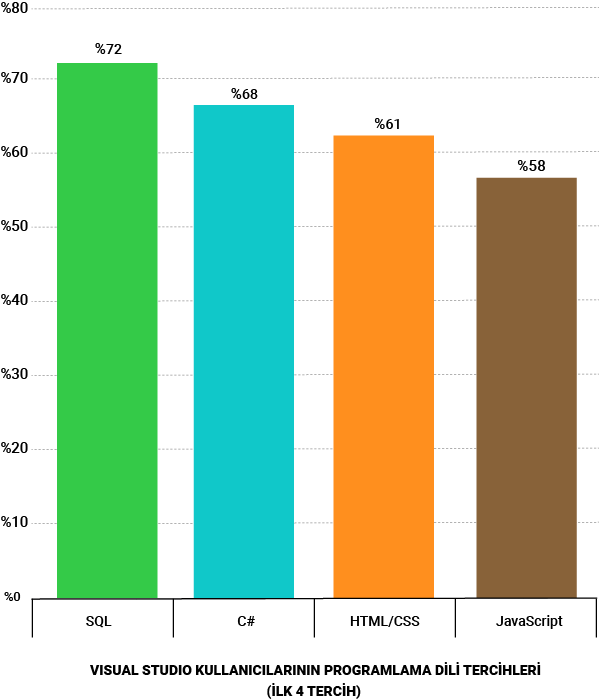
Operating Systems
-
CURRENTLY USED
-
INTENDED TO BE USED
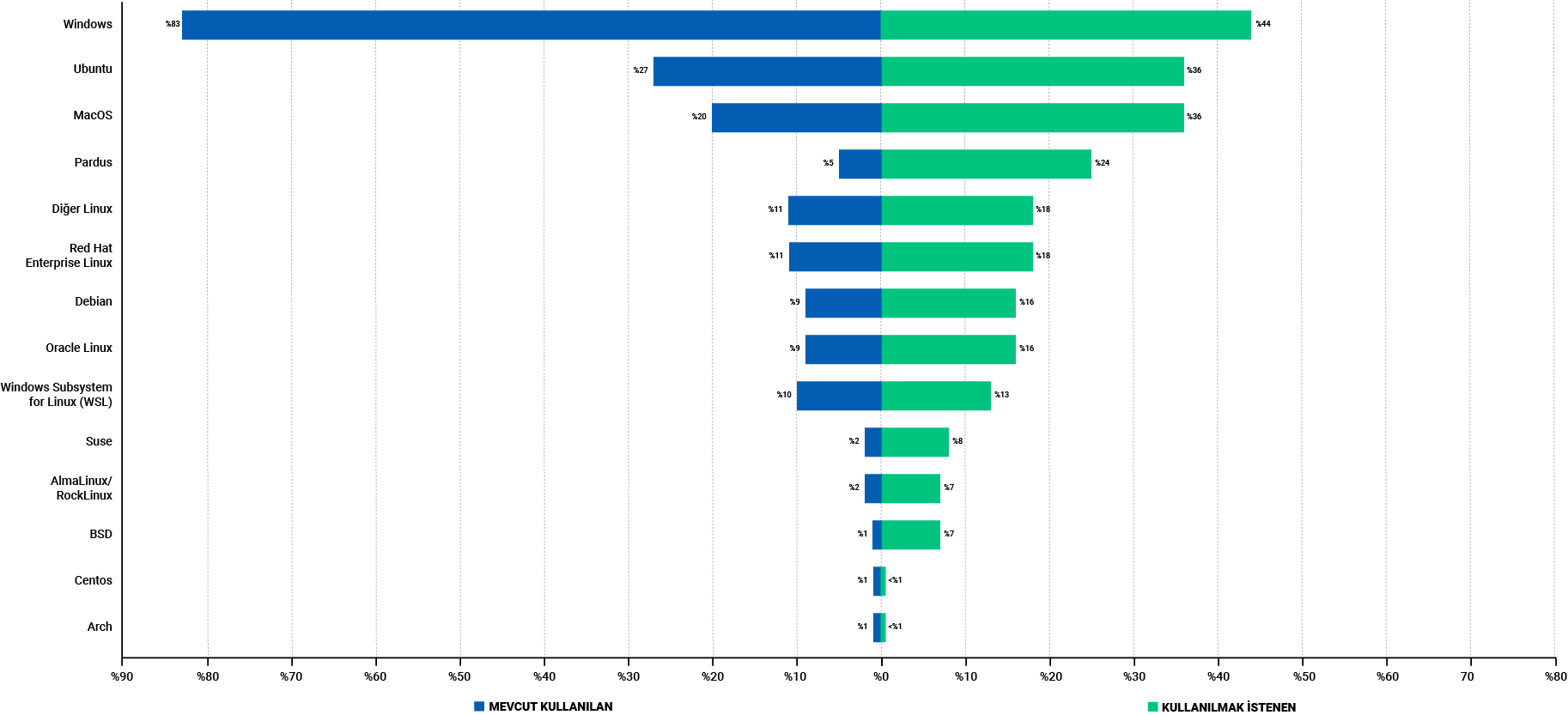
Version Control Systems
Version Control Systems
-
SATISFIED
-
WILLING
-
CURRENTLY USED
Source Code Repository Management
-
CURRENTLY USED
Version Control Systems
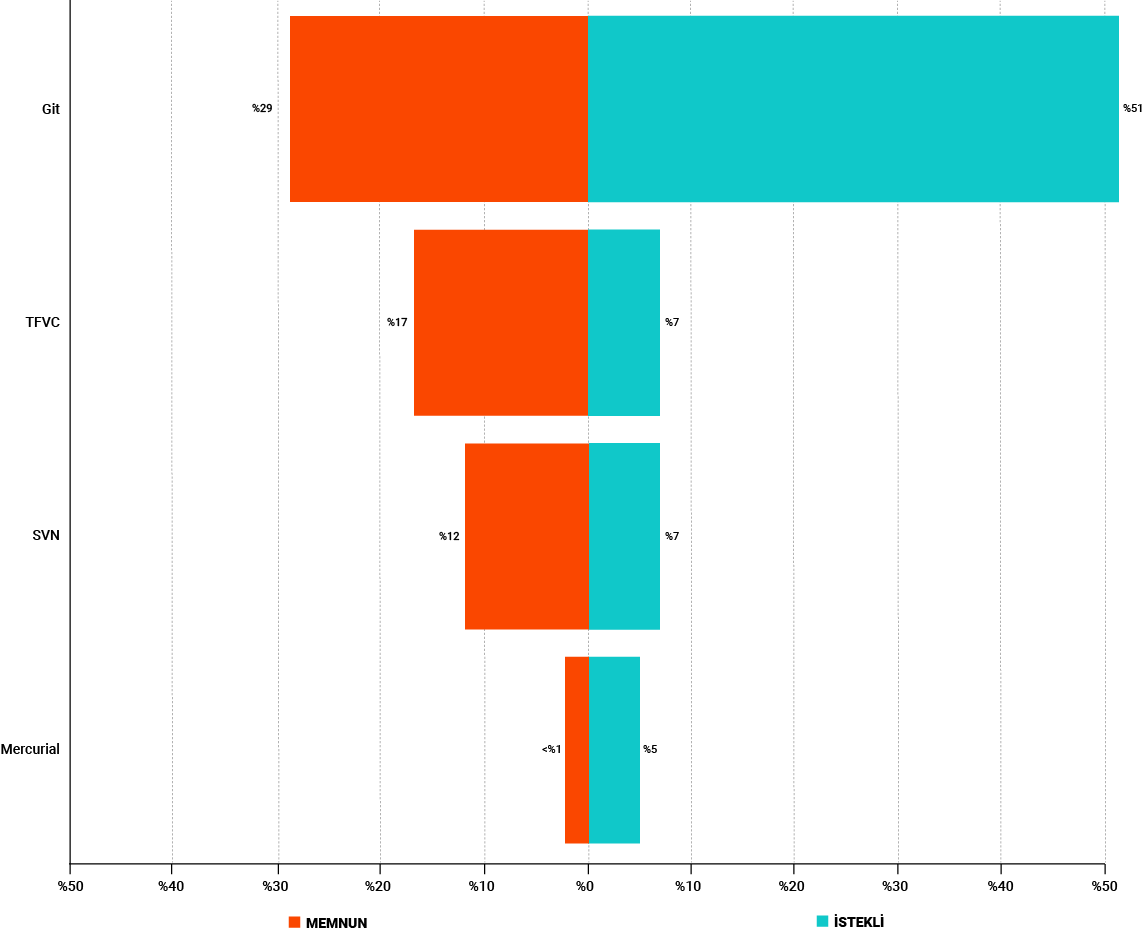

Source Code Repository Management
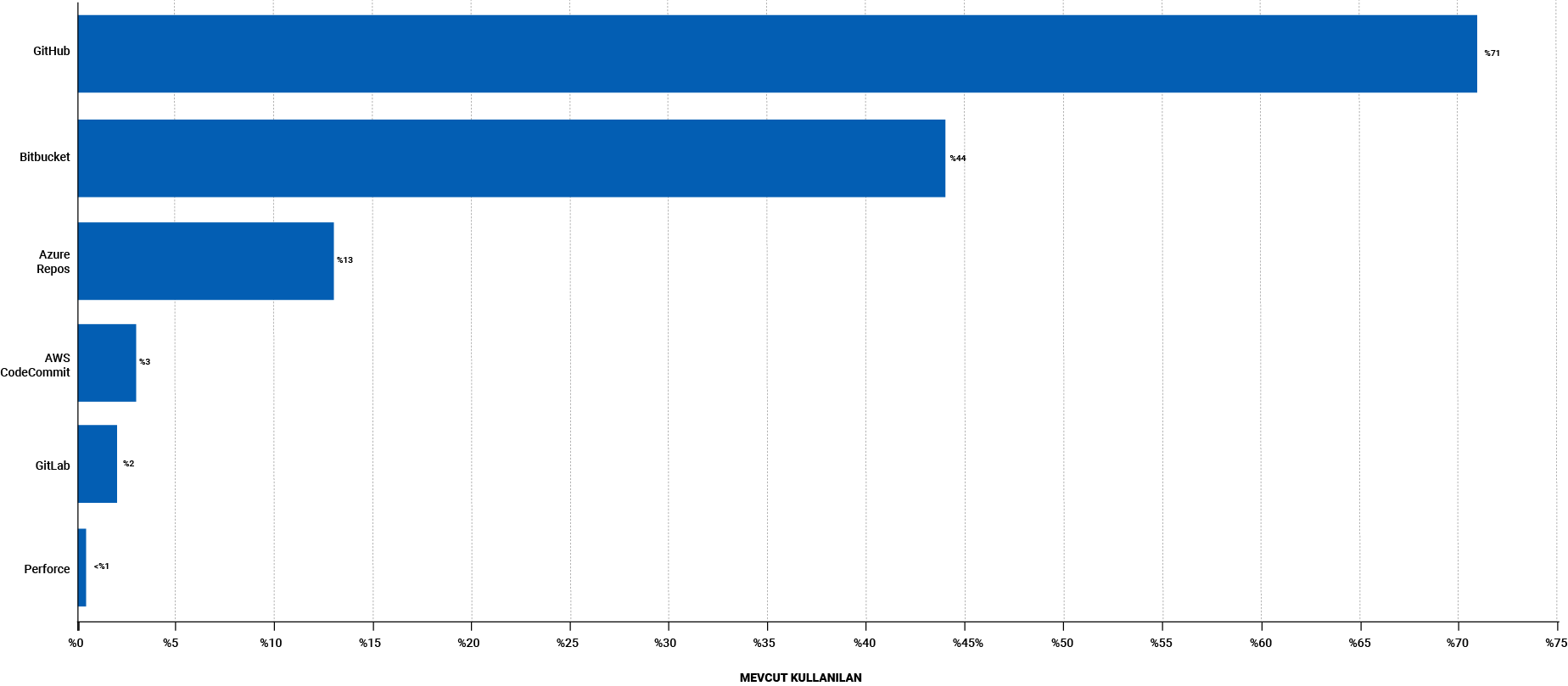

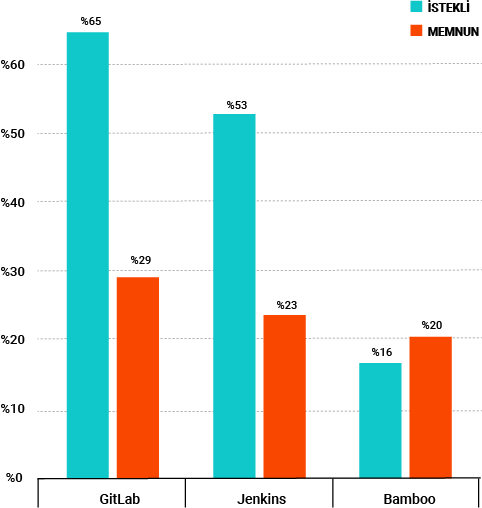
-
CURRENTLY USED
-
WILLING
-
SATISFIED
Cloud and Virtualization Usage
Cloud and Virtualization Usage - Public Institutions
-
CURRENTLY USED
-
INTENDED TO BE USED
Cloud and Virtualization Usage - Private Sector
-
CURRENTLY USED
-
INTENDED TO BE USED
-
WILLING
-
SATISFIED
In terms of future perspective, we can say that AWS and Microsoft Azure are the most popular solutions among those who will experience them for the first time. From this perspective, we see that VMware and Microsoft HyperV will lag behind in the private sector. Additionally, we can express that Turkcell Cloud, a domestic cloud provider, and Safir Cloud, developed by TÜBİTAK BİLGEM, will be more preferred in the future.
Cloud and Virtualization Usage - Public Institutions
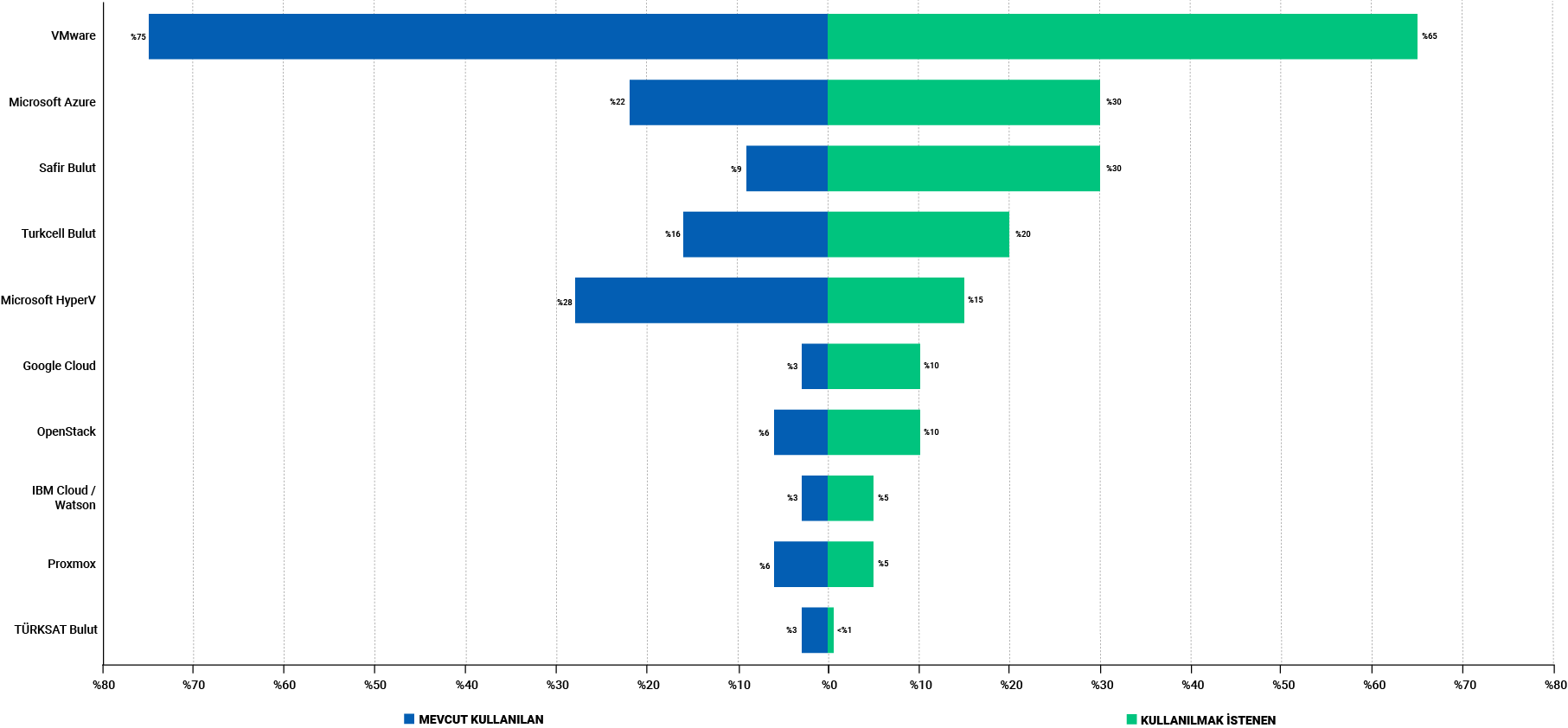
Cloud and Virtualization Usage - Private Sector
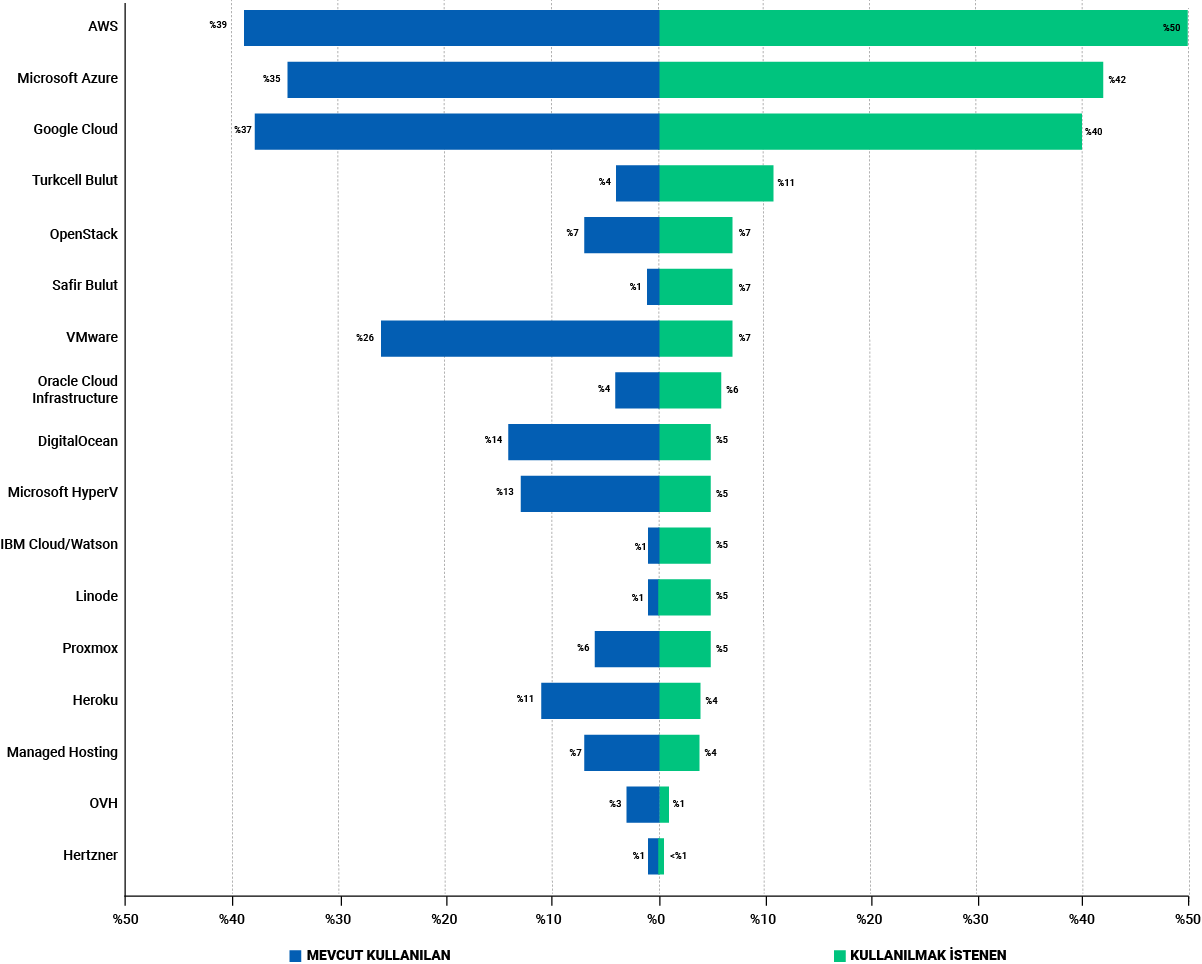
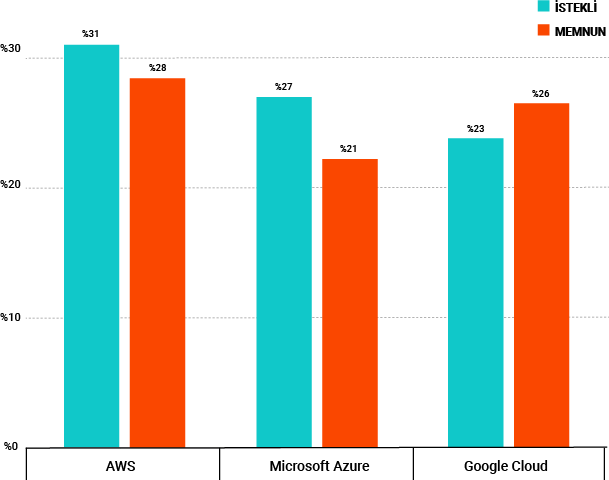
In terms of future perspective, we can say that AWS and Microsoft Azure are the most popular solutions among those who will experience them for the first time. From this perspective, we see that VMware and Microsoft HyperV will lag behind in the private sector. Additionally, we can express that Turkcell Cloud, a domestic cloud provider, and Safir Cloud, developed by TÜBİTAK BİLGEM, will be more preferred in the future.
Logging and Monitoring Tools
-
CURRENTLY USED
-
INTENDED TO BE USED
-
WILLING
-
SATISFIED
We observe that the usage of tools such as Pinpoint and Sentry, used as application performance monitoring tools, remains low. Similarly, Jaeger, which offers an open-source solution for distributed tracing, has not achieved widespread usage.
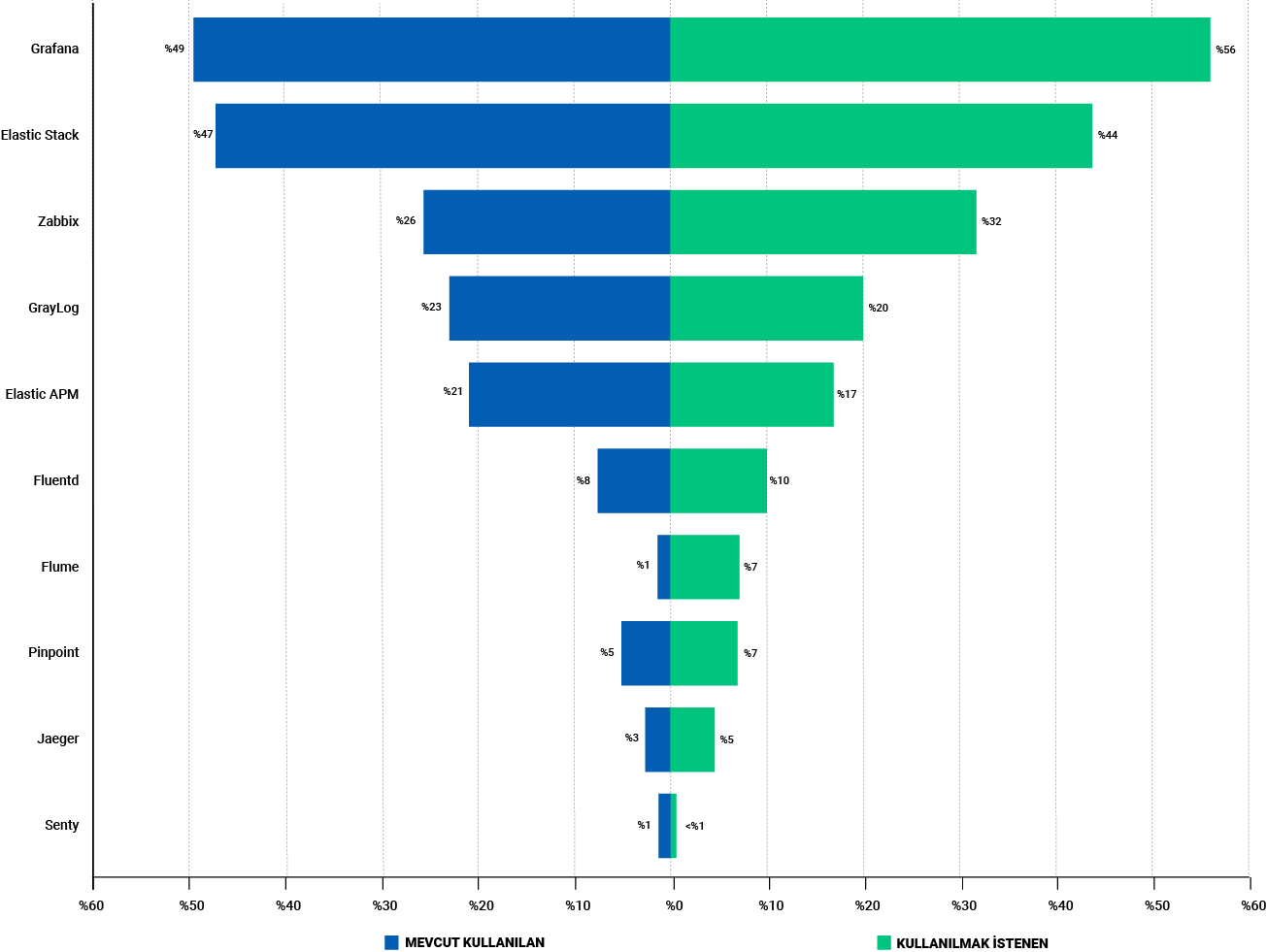

We observe that the usage of tools such as Pinpoint and Sentry, used as application performance monitoring tools, remains low. Similarly, Jaeger, which offers an open-source solution for distributed tracing, has not achieved widespread usage.
Project Management Methodologies
Project Management Methodologies Usage Status
-
CURRENTLY USED
-
INTENDED TO BE USED
Satisfaction Status of Project Management Methodologies
-
WILLING
-
SATISFIED
Project Management Methodologies Usage Status
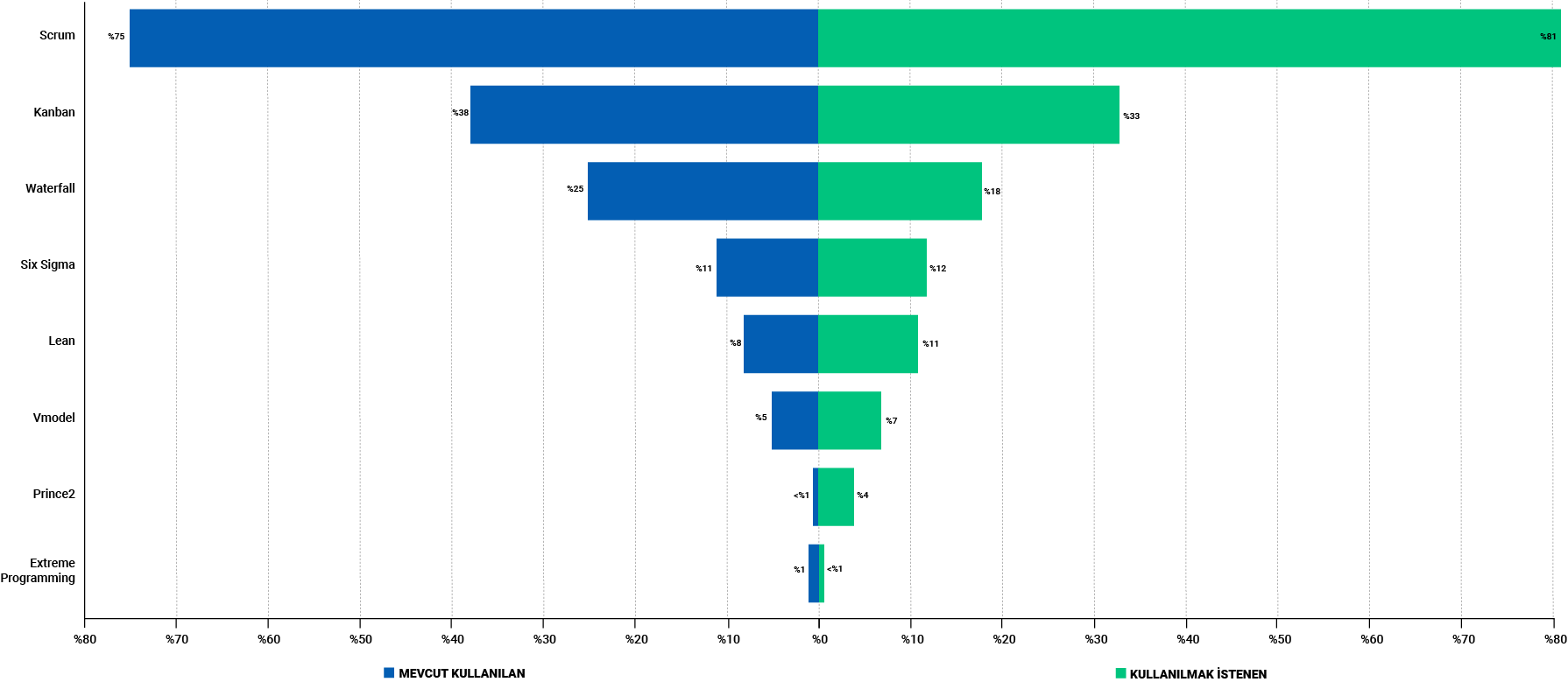
Satisfaction Status of Project Management Methodologies
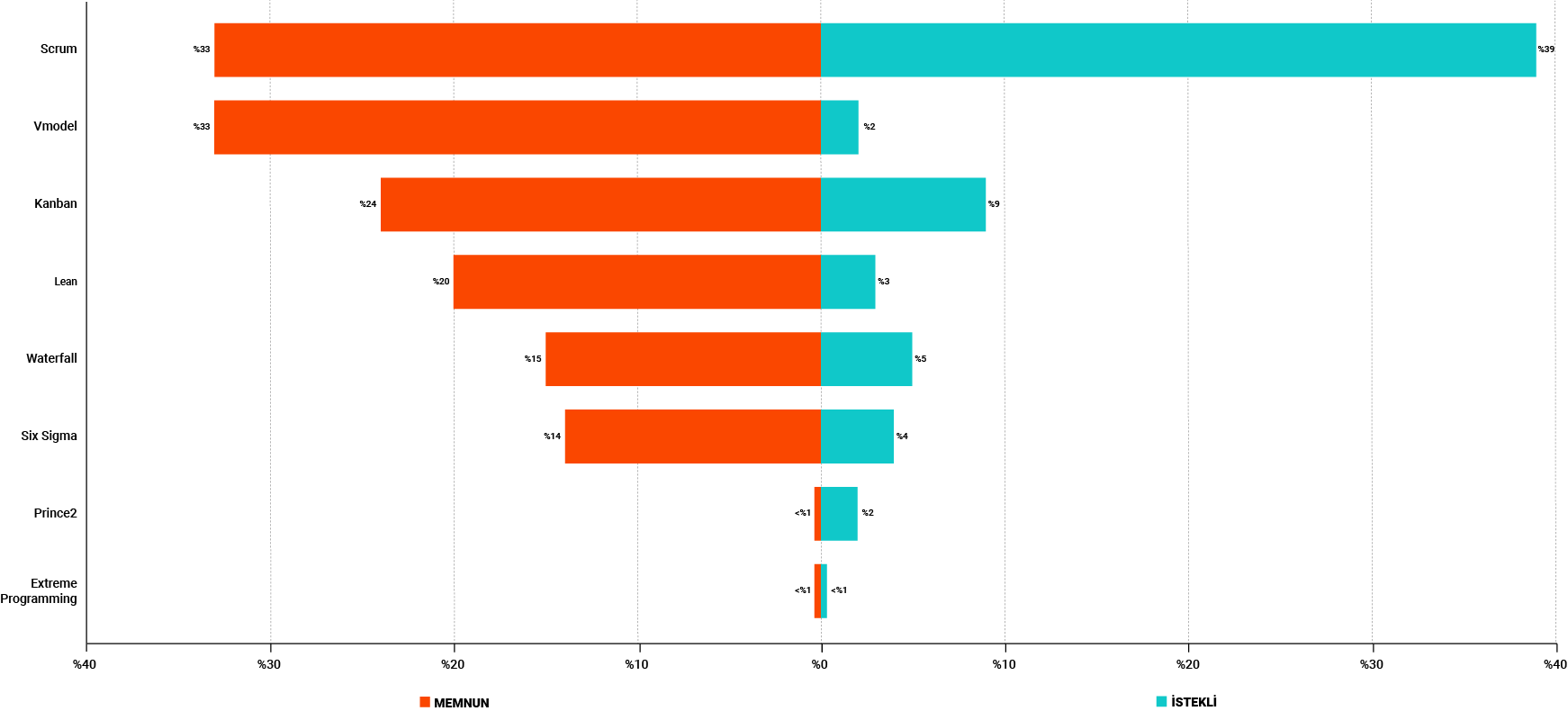
Project Management Tools
-
CURRENTLY USED
-
INTENDED TO BE USED
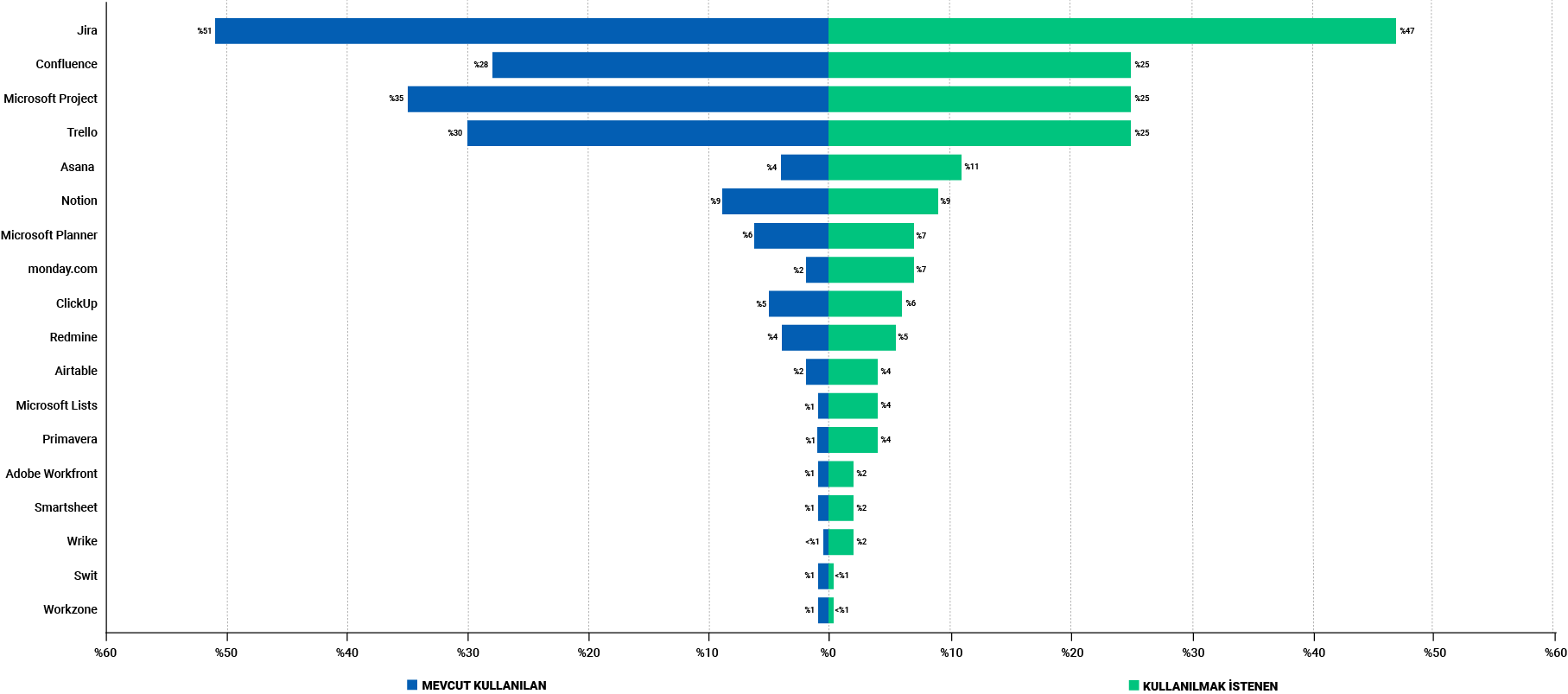
Communication Tools
Usage of Communication Tools - Türkiye
Usage of Communication Tools - Global
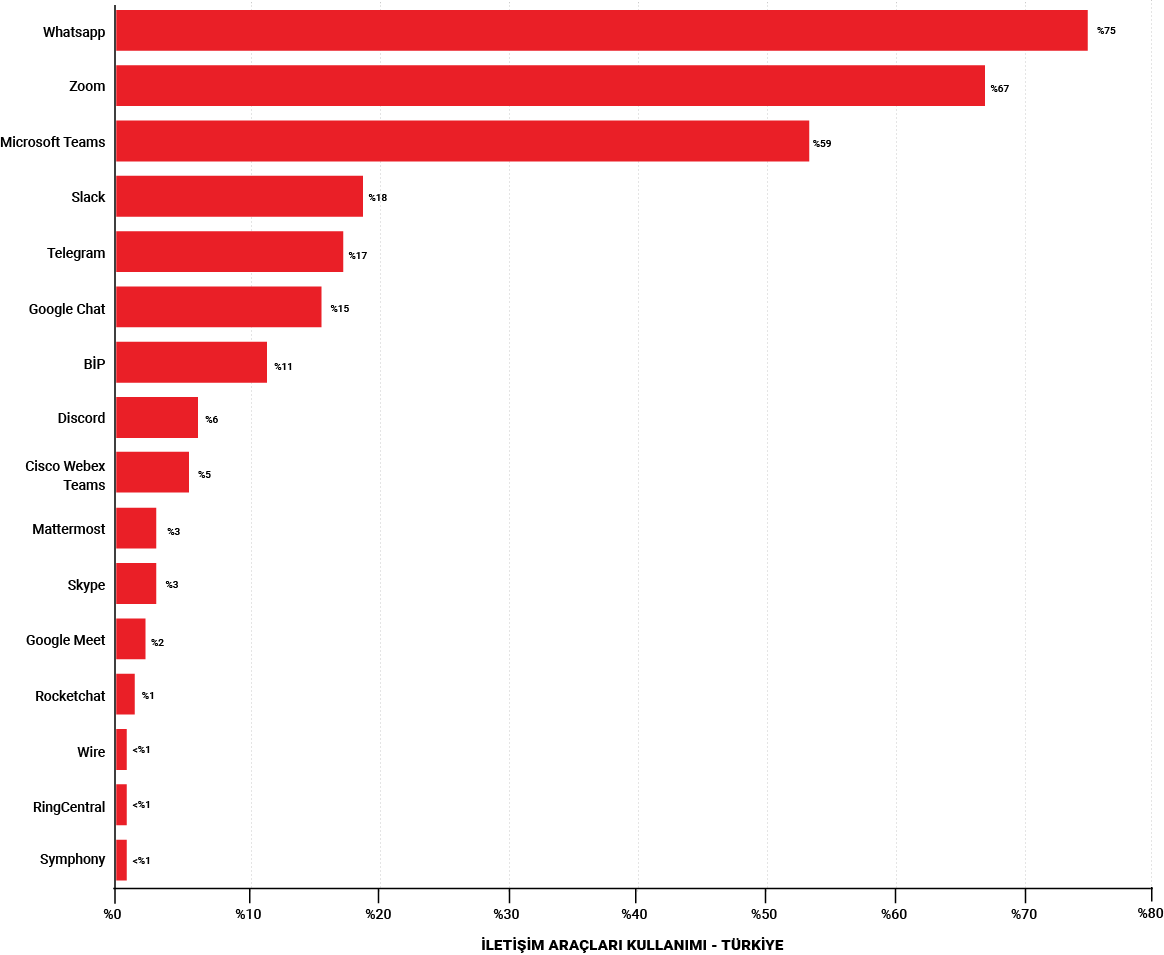
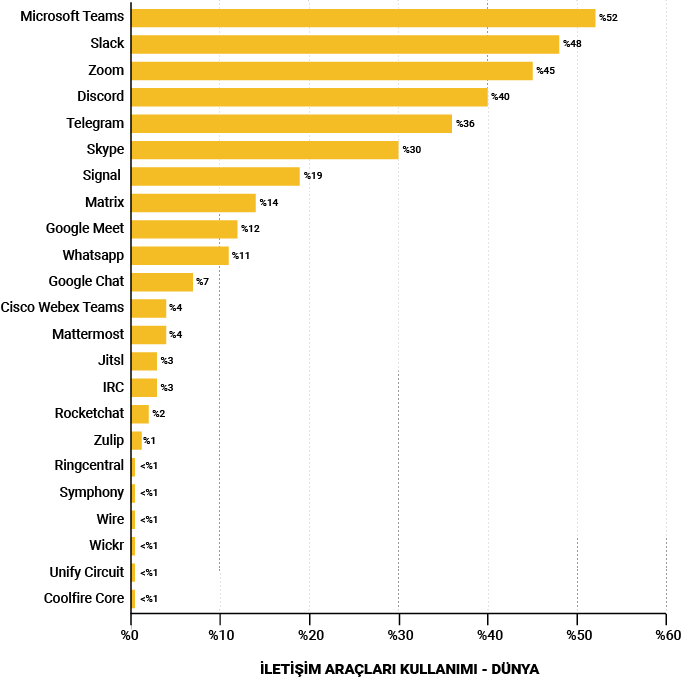
Current and Needed Roles In the Software Industry
-
EMPLOYED
-
INTENDED TO BE EMPLOYED
[1] Stack Overflow. “2023 Developer Survey”. Accessed at https://survey.stackoverflow.co/2023.
